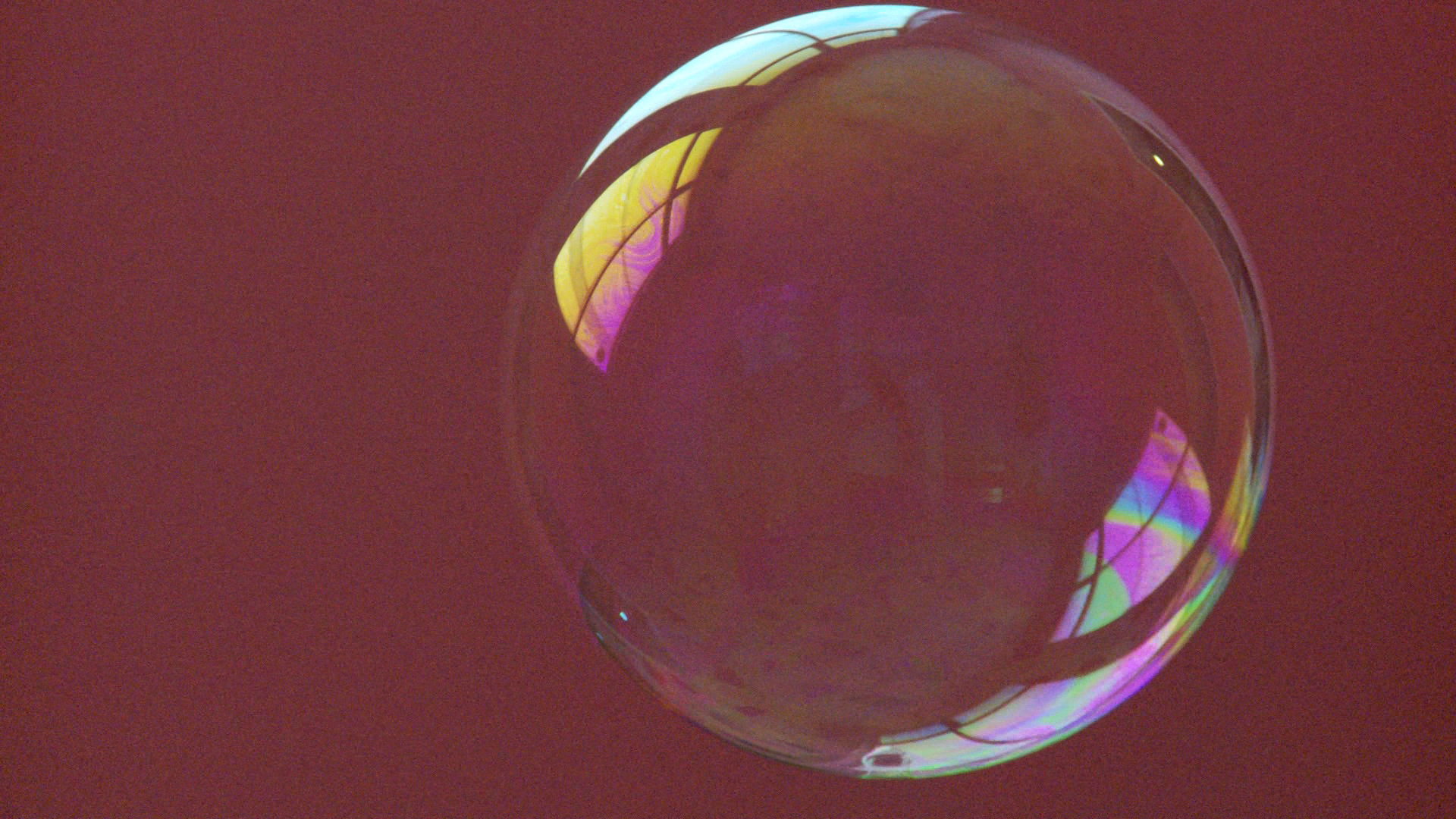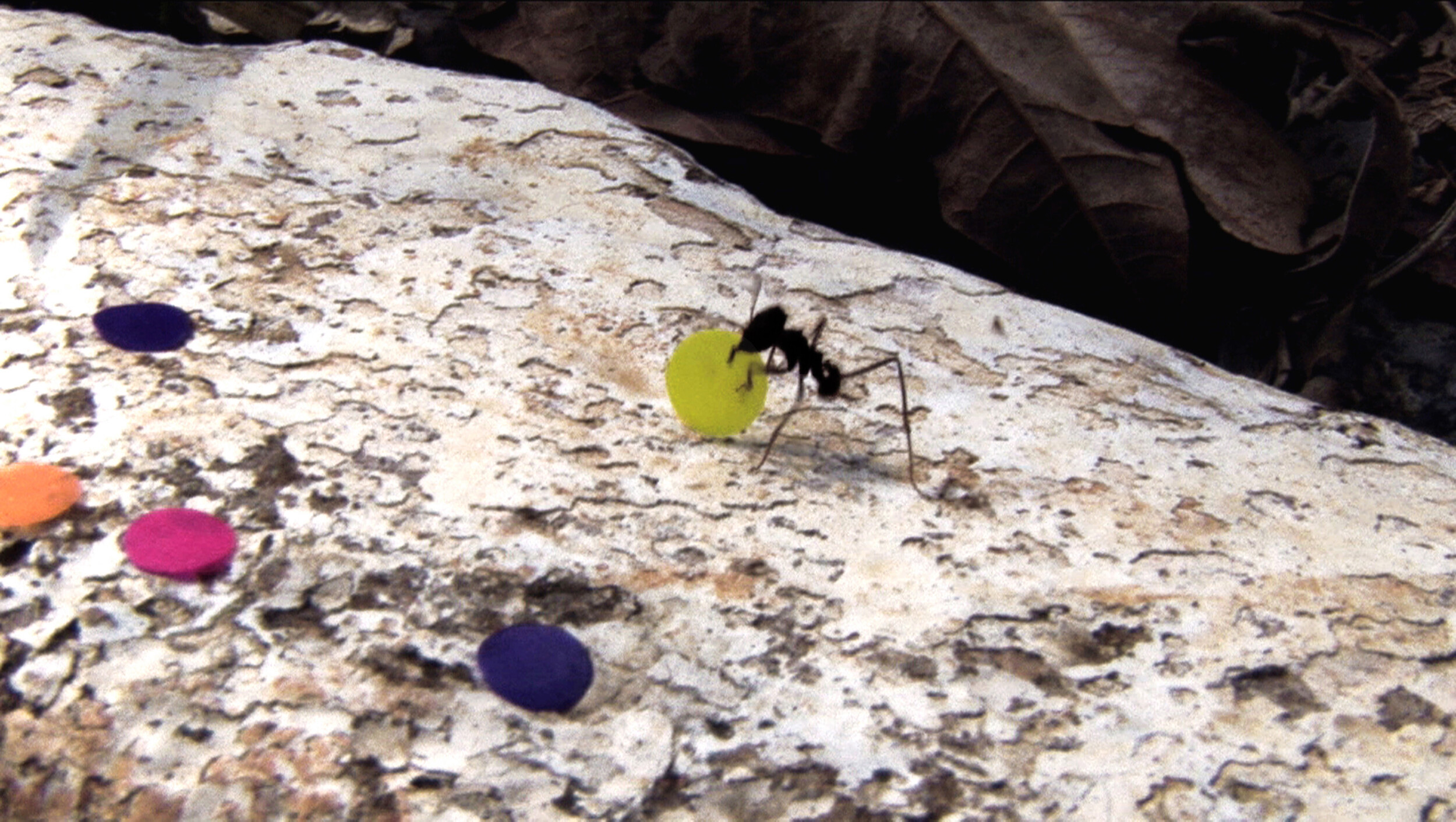Rivane Neuenschwander and Cao Guimarães, The Tenant, 2010. High definition video projection, 10:34, video still. Courtesy of the artists.
Rivane Neuenschwander and Cao Guimarães: Signs of Life
Art Writing and Criticism Students, Amy May Stuart and Rex Butler
When will the bubble burst? It’s a question we ask of stock markets, Taylor Swift, and life itself. It’s a question we also ask as we watch Brazilian artists Rivane Neuenschwander and Cao Guimarães’s video The Tenant (2010), currently showing in the exhibition Signs of Life at the Fiona and Sidney Myer Gallery at the Victorian College of the Arts.
As a group of Monash undergraduate students, we collectively watch a large iridescent soap bubble float through a series of rooms in a seemingly vacant house undergoing renovation. In one shot, the bubble floats past a bright pink wall in the process of being repainted. In another, it’s stalked by the camera as it hurriedly crosses a floor covered with Portuguese-language newspapers. The camera obsessively tracks this otherworldly orb in closely cropped detail, and though we are able to catch a glimpse of the cameraperson’s reflection in the bubble they remain strangely inscrutable. In the final shot, the bubble appears to float up a flight of stairs to the second story of the house, which we never see.

Of course, we gradually realise that it can’t be the same bubble filmed throughout the video. In each shot it must be a different one—hand-or mouth-blown after the inevitable popping of its predecessor. But the illusion that it is a single bubble remains, and as the video progresses the tension rises whether it will burst before the end. This seemingly inevitable event is forever deferred, however. There it floats in the last scene, rising mysteriously up the stairs (undoubtedly encouraged by an off-screen puff of air), like a levitating ghost or Holy Spirit.
On the other side of the gallery is the exhibition’s second work—there are only the two, both exhibited as large projections—another collaborative video by Neuenschwander and Guimarães. Quarta-Feira de Cinzas/Epilogue (Ash Wednesday) (2006) depicts a colony of ants hefting discs of brightly coloured confetti back to their nest. At first, we see the ants working solo; one ant carries a shining gold circle aloft in its mandibles, another doggedly drags a blue piece along the forest floor. Then, collaborating in pairs and groups, the ants are shown ferrying these apparently sugar-coated bits of confetti down into their nest, perhaps to feed the queen and her babies. The video ends at this threshold, not unlike The Tenant’s bubble disappearing upstairs, where the confetti-laden ants vanish into the ground.

Here we wonder about the various presences and absences suggested by Neuenschwander and Guimarães’s videos in their pairing. Is the tenant of The Tenant the bubble itself, or does this title indicate a displaced human occupant? If it is the bubble, this tenant is certainly hovering at the edges of presence in its ghostly, ephemeral existence. The cameraperson, too, seems caught between these two states. Similarly, Quarta-Feira de Cinzas offer an absent human intervention through the seemingly incongruous appearance of confetti on a forest floor. The ants, on the other hand, are overt in their presence, as they wave around their (comparatively) enormous, colourful placards against dull shades of brown and grey.
This scattering of confetti on the ground seems at once both logical and out of place. This material, we realise, is generally associated with celebrations and parties, attaining its moment of glory as it flies through the air (bubbles, anyone?) before floating down to earth. In this case, we consider that Brazilian celebration par excellence, the Carnival—an annual festival that begins on a Friday and ends five and a half days later at midday on Ash Wednesday, marking the beginning of the forty days of Lent. During Lent, many Catholics and various Christian denominations observe a solemn period of penitence, prayer, and fasting, which ends at Easter and the celebration of Jesus’s resurrection. Significantly, almost seventy percent of Brazil’s population is now Catholic—the religion being originally brought over by Portuguese settler-colonists and forcefully imposed on the Indigenous people at the beginning of the sixteenth century.
In a further Carnival-esque allusion, we notice that amongst the diegetic forest sounds of Quarta-Feira de Cinzas is a catchy clicking, tapping beat: later understood to be a version of the samba. One of the most popular and enduring styles of music and dance at Carnival, Neuenschwander, and Guimarães’s version (composed by the Brazilian experimental music duo O Grivo) has been performed with matchsticks on a tabletop: a samba for ants.

As suggested by the work’s title, are we witnessing the ants take advantage of some Carnival-generated detritus? Can we think about the confetti (and the bubble) in some relation to Ash Wednesday, Lent, and the resurrection of Christ? We’re going to make a big jump in connecting the two works, but before that, a word from their sponsor. When we visited, the gallery director and curator of Signs of Life David Sequeira delivered for us an impassioned speech about how he wanted people to experience the works in the flesh, as it were, and not just watch them online. He spoke about how, after first viewing it in a museum collection, he kept images of Quarta-Feira de Cinzas in his office, living with them for quite some time—as he does with nearly all the works he exhibits or writes about—before deciding what to pair with it. Sequeira tells us that he was utterly taken by Quarta-Feira de Cinzas; however, he didn’t immediately know how he wanted to curate the work into an exhibition. It was only when Sequeira viewed The Tenant that he decided that he had enough to make a show out of, that the two works spoke profoundly to each other; but also, he cautioned, he didn’t simply want to instruct the audience how to relate to them. He wanted them to discover and connect with the works themselves, and for him this could only happen if they stood there in the space and gave the works some time in our busy, distracted world.
And we have to say this happened to us, as we collectively stood there. First, we noticed that the two featured objects is each video were round: the floating bubble and the grounded confetti. Then we noticed that they also shared many of the same colours: the iridescent reflections of a soap bubble, which if you remember are often pink, green, blue, and bright reflected white; and the pink, green, and silver of the confetti pieces being dragged into the ant’s nest. We mused on these formal resonances, alongside discussions of endurance and ephemerality, presence, and absence, and human and non-human agency. Something that seemed to linger, however, was the sense of otherworldliness and haunting evoked by The Tenant, and the link to Jesus’ passage from crucifixion to resurrection drawn in Quarta-Feira de Cinzas.
Here’s where we draw our long bow, our proposal for a reading of the two works together, which took us several days to make, but is exactly the kind of spectatorial creativity (we think) Sequeira hopes the works of art he shows us inspire. We suggest that perhaps what we see in Quarta-Feira de Cinzas is Christ as confetti being buried by his disciples as ants—“remember you are dust, and to dust you will return,” is the invocation spoken by priests when ritually applying ashes to worshipper’s heads on Ash Wednesday. Further, we propose that, within this reading, The Tenant’s bubble could be understood as Christ’s ascension to heaven after his momentary tenancy on here earth.

Tenuous? Maybe. But it might allow us to give a political meaning to the two videos, or at least the pairing of them together—perhaps to even reflect on issues facing contemporary Brazil, although we realise that’s a little presumptive on our part. But it occurs to us how strange and disturbing it is that those pieces of confetti after the Carnival celebrations are found in what looks like a jungle—and it is, in fact, the Amazon rainforest—by the ants. What are humans doing scattering their sugared shit everywhere? And then we have the resurrected Christ surveying and maybe casting a judgement on that decrepit, emptied out tenant house (and, if we could read Portuguese, we would bet that those newspapers on the floor feature the usual bad news stories of our contemporary world: environmental degradation, murders, housing crises, political corruption).
Brazil over the past ten years has had a disastrous far-right populist Trump-like President Jair Bolsonaro, who seemingly has done as much as possible to destroy the Amazon rainforest. Before him, around the time the videos were made, there was two-time President Lula da Silva, a Leftist and reformer. In October 2022 da Silva was re-elected in a tight contest with Bolsonaro, just three years after being put into jail on likely trumped-up charges of corruption. Perhaps exhibited together and in our current context, we can read the videos as an allegory of the resurrection of da Silva and the return of some form of democracy to Brazil.
Is this too much to suggest? Is this to reduce the two videos to a kind of right-on political message? Maybe.
But that’s how they made us feel when we watched them and in the days after. Hopeful. Redemptive. Resurrected. Art can do that sometimes. Even when it’s part of a class exercise for a university course. Go and see The Tenant and Quarta-Feira de Cinzas at the Fiona and Sidney Myer Gallery. Spend some time with them. Turn off your phone. Look and listen closely. (The soundtracks are very quiet.) For a moment, you’ll be transported. You’ll be a bubble, and for the entire ten minutes and thirty-four seconds of The Tenant the bubble will not burst.
This review was written by art writing and criticism students alongside Amy May Stuart and Rex Butler. Special mention is made of Julianne Javier, Alida Worthy, Charli Dunstan, Zoe Kerruish, Megan Willey, Divyanshi Sharma, Theo Dryden, Lucy Gordon, Grace Anderson, Esther Ong, Maeve Carpenter, Kate Mcdonald, Amelia Campagna, Luna Olivain and Katy Tomiak. Amy May Stuart is an artist living in Naarm (Melbourne), Australia. Rex Butler teaches Art History in the Faculty of Art Design and Architecture at Monash University.